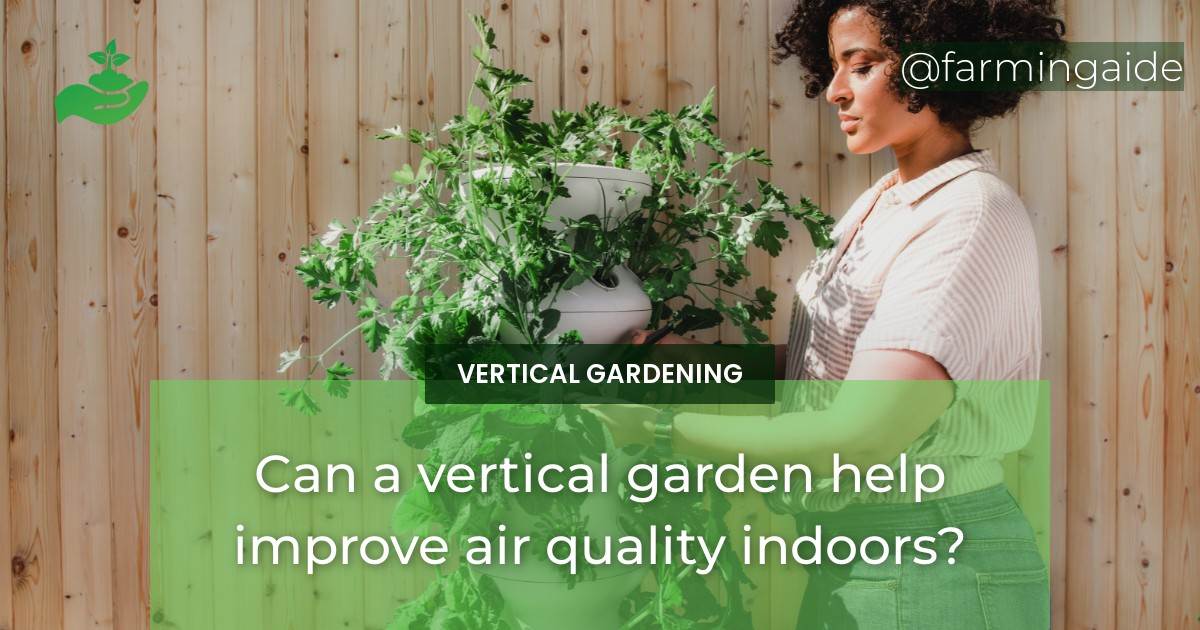Can a vertical garden help improve air quality indoors? The answer is yes! Vertical gardening not only adds a touch of greenery to indoor spaces but also has air purifying benefits. Plants are known to filter out toxins from the air through the process of photosynthesis, making them an excellent addition to any indoor space. Vertical gardening takes up minimal space and can be done in small apartments, making it a popular trend among urban dwellers who seek to improve their indoor air quality.
Air-purifying plants suitable for vertical gardening
Snake Plant
The snake plant is a hardy plant that can survive in low-light conditions, making it perfect for an indoor vertical garden. It filters out formaldehyde, benzene, and trichloroethylene from the air, making it a top choice for improving indoor air quality.
Spider Plant
Spider plants are easy to care for and can thrive in a variety of lighting conditions. They are known to filter out formaldehyde and xylene and are often recommended for use in indoor vertical gardens.
Peace Lily
Peace lilies are beautiful plants that are easy to care for and have air-purifying benefits. They filter out formaldehyde, benzene, and trichloroethylene from the air and are a popular choice for indoor vertical gardens.
English Ivy
English Ivy is a fast-growing plant that is perfect for vertical gardening. It has air-purifying benefits, including the ability to filter out formaldehyde and benzene from the air.
Boston Fern
Boston Ferns are a popular choice for indoor vertical gardens due to their air-purifying benefits. They filter out formaldehyde, xylene, and toluene from the air, making them an excellent choice for improving indoor air quality.
Bamboo Palm
Bamboo palms are tropical plants that are perfect for indoor vertical gardens. They filter out formaldehyde, benzene, and trichloroethylene from the air, making them an excellent choice for improving indoor air quality.
Golden Pothos
Golden Pothos is a fast-growing vine that is easy to care for and perfect for indoor vertical gardens. It filters out formaldehyde, benzene, and xylene from the air, making it a top choice for improving indoor air quality.
Placement and care tips for indoor air quality improvement
Placement tips for vertical gardening
- Place your vertical garden near a window where it can receive adequate sunlight.
- Make sure your plants have enough space to grow and aren’t crowded or cramped.
- Consider the temperature and humidity of your indoor space when choosing plants for your vertical garden.
Indoor air quality care tips for vertical gardening
- Regularly dust the leaves of your plants to remove any accumulated dirt or dust.
- Monitor the humidity levels in your indoor space and adjust watering accordingly.
- Check your plants regularly for signs of pests or disease and treat them promptly.
Watering and fertilizing tips for air-purifying plants
- Water your plants regularly but avoid overwatering, which can lead to root rot.
- Use a high-quality fertilizer to give your plants the nutrients they need to thrive.
- Follow the instructions on your fertilizer carefully, as overfertilization can harm your plants.
ALSO READ
Other benefits of having a vertical garden indoors
Aesthetically pleasing
Vertical gardens add a touch of greenery to indoor spaces and can be customized to match any decor style. They are a beautiful and aesthetically pleasing addition to any indoor space.
Space-saving solution
Vertical gardens take up minimal space and are perfect for small apartments or homes with limited outdoor space. They provide a space-saving solution for those who want to add greenery to their indoor spaces.
Stress-relieving benefits
Studies have shown that spending time around plants can have stress-relieving benefits, making vertical gardens a great addition to any indoor space.
DIY methods for creating a vertical garden indoors
Using repurposed materials
Vertical gardens can be created using repurposed materials such as pallets, old gutters, or shoe organizers. This is a cost-effective and eco-friendly way to create a vertical garden indoors.
Utilizing a trellis or grid system
A trellis or grid system can be used to create a vertical garden indoors. This provides support for climbing plants and makes it easy to change the arrangement of your plants as needed.
Creating a hydroponic system
Hydroponic systems are a popular choice for indoor vertical gardens. They allow for easy watering and nutrient delivery and can be customized to fit any indoor space.
ALSO READ
Can Vertical Gardens Specifically Improve Indoor Air Quality?
Vertical gardening is an effective way to improve indoor air quality. The benefits of vertical gardening include air purification and reduction of indoor pollutants. By incorporating various plants into vertical gardens, such as spider plants and peace lilies, you can enhance the quality of the air inside your home or office.
Conclusion
Recap of benefits of vertical gardening for indoor air quality
Vertical gardening is a great way to improve indoor air quality by adding air-purifying plants to your indoor space. Plants such as snake plants, spider plants, and peace lilies are known to filter out toxins from the air, making them a top choice for use in indoor vertical gardens.
Encouragement to try vertical gardening as a solution for improving indoor air quality
If you’re looking for a way to improve your indoor air quality and add a touch of greenery to your space, consider creating a vertical garden. With the right plants and care, a vertical garden can be a beautiful and beneficial addition to any indoor space.
RELATED ARTICLES:


